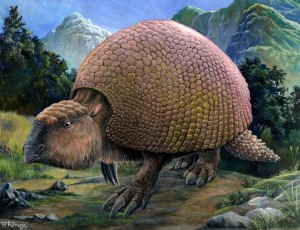Monster Monday: Armadillos of Unusual Size
July 11, 2016

Glyptodont
Credit: Pavel Riha (licensed under CC BY-SA 3.0)
They say everything is bigger in Texas. But that state’s modern day mascot, the humble armadillo, is no match for its prehistoric cousin—the glyptodont. Although modern armadillos range in length from about 6 inches to 5 feet (15 centimeters to 1.5 meters), some species of glyptodont grew to over 10 feet (3 meters) long, the size of a small car.
This tanklike mammal lived in what is now South America during the Pleistocene Epoch, a time in Earth’s history that lasted from about 2.6 million years ago to 11,500 years ago. During the Pleistocene, many gigantic creatures roamed Earth, including mammoths and giant sloths. The saber-toothed cat and other Pleistocene predators had to be powerful to take down their giant prey. Glyptodont was protected from such monstrous beasts by a thick skullcap on its head and a massive carapace (shell) of bones that covered most of its body. Over 1,000 skin-covered bony plates made up this robust armor, which could weigh over 1,100 pounds (500 kilograms). Glyptodont was the most heavily armored vertebrate (animal with a backbone) that has ever lived.
The tails of some glyptodonts were tipped with a large, spiky club. In addition to warding off predators, these powerful weapons were used in fights with rivals during the mating season. Males clubbed one another’s carapaces, damaging the bony plates.
As invincible as such a beast might seem, Glyptodont disappeared at the end of the last ice age. Some scientists think that hunting by prehistoric people may have contributed to the extinction of these formidable creatures.


